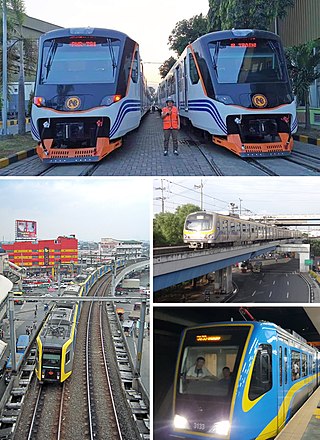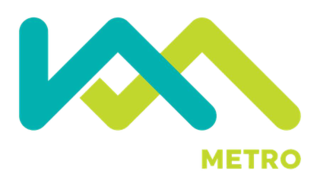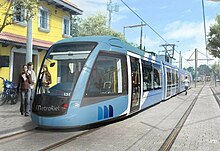
MetroLink is the Greater St. Louis Metropolitan mass transit system serving Missouri and the Metro East area of Illinois. The system consists of two rail lines connecting St. Louis Lambert International Airport and Shrewsbury, Missouri, with Scott Air Force Base near Shiloh, Illinois, Washington University, Forest Park, and Downtown St. Louis. The system operates as underground subway in Downtown St. Louis and as underground subway through portions near Forest Park and Clayton to the west. The system features 38 stations and is the only light rail system in the United States to cross state lines. In 2022, the system had a ridership of 6,702,600, or about 20,500 per weekday as of the fourth quarter of 2022. As of the third quarter of 2020, it is second only to Minneapolis Metro Transit in the Midwestern United States in terms of light rail ridership, and is the 11th-largest light rail system in the country.

The E Line is a 22-mile (35 km) light rail line that runs between Santa Monica and East Los Angeles. It is one of the six lines in the Los Angeles Metro Rail system and is operated by the Los Angeles County Metropolitan Transportation Authority (Metro).

Rail transportation in the Philippines is currently used mostly to transport passengers within Metro Manila and provinces of Laguna and Quezon, as well as a commuter service in the Bicol Region. Freight transport services once operated in the country, but these services were halted. However, there are plans to restore old freight services and build new lines. From a peak of 1,100 kilometers (680 mi), the country currently has a railway footprint of 533.14 kilometers (331.28 mi), of which only 129.85 kilometers (80.69 mi) are operational as of 2023, including all the urban rail lines. World War II, natural calamities, underspending, and neglect have all contributed to the decline of the Philippine railway network. In the 2019 Global Competitiveness Report, the Philippines has the lowest efficiency score among other Asian countries in terms of efficiency of train services, receiving a score of 2.4, and ranking 86th out of 101 countries globally. The government is currently expanding the railway network up to 1,900 kilometers (1,200 mi) by 2022 through numerous projects.

The MAX Green Line is a light rail service in Portland, Oregon, United States, operated by TriMet as part of the MAX Light Rail system. It is 15 miles (24.1 km) long and serves 30 stations from the PSU South stations to Clackamas Town Center Transit Center; it connects Portland State University (PSU), Portland City Center, Northeast Portland, Southeast Portland, and Clackamas. The Green Line is the only service that shares parts of its route with the four other MAX services, sharing the Portland Transit Mall with the Orange and Yellow lines and the Banfield segment of the Eastside MAX with the Blue and Red lines. Southbound from Gateway/Northeast 99th Avenue Transit Center, it operates the Interstate 205 (I-205) segment through to Clackamas Town Center. Service runs for approximately 211⁄2 hours daily with a headway of 15 minutes during most of the day. It is the third-busiest line in the system, carrying an average of 19,160 riders per day on weekdays in September 2019.

The Purple Line is a 16.2-mile (26.1 km) light rail line being built to link several Maryland suburbs of Washington, D.C.: Bethesda, Silver Spring, College Park, and New Carrollton. Slated to open in 2026, the line will also enable riders to move between the Maryland branches of the Red, Green, and Orange lines of the Washington Metro without riding into central Washington, and between all three lines of the MARC commuter rail system. The project is administered by the Maryland Transit Administration (MTA), an agency of the Maryland Department of Transportation (MDOT), and not the Washington Metropolitan Area Transit Authority (WMATA), which operates Metro.

The T Third Street is a Muni Metro light rail line in San Francisco, California. It runs along the east side of San Francisco from Sunnydale to Chinatown, traveling in the median of Third Street for most of its length before entering the Central Subway as it approaches downtown. The line serves 22 stations, all of which are accessible. Most of the surface portion of the line runs in dedicated median lanes, though two portions operate in mixed traffic.

The East Link Extension, also known as the 2 Line, is a future light rail line serving the Eastside region of the Seattle metropolitan area in the U.S. state of Washington. It will be part of Sound Transit's Link light rail system, running 14 miles (23 km) from west to east and serving 10 stations in Downtown Seattle, Mercer Island, Bellevue, and Redmond. The 2 Line is scheduled to open in 2024 and will continue into the Downtown Seattle Transit Tunnel and share stations with the 1 Line. A 3.7-mile-long (6.0 km) extension to Downtown Redmond with two additional stations is scheduled to open in 2025.

The Kochi Metro is a rapid transit system serving the city of Kochi in Kerala, India. It was opened to the public within four years of starting construction, making it one of the fastest completed metro projects in India. The Kochi metro project is the first metro in the country which connects rail, road and water transport facilities. The first phase is being set up at an estimated cost of ₹51.81 billion (US$650 million). In October 2017, Kochi Metro was named the Best Urban Mobility Project in India by the Urban Development Ministry, as part of the Urban Mobility India (UMI) international conference hosted by the ministry every year. The Kochi Water Metro is integrated with the Kochi Metro, which serves as a feeder service to the suburbs along the rivers where transport accesibility is limited.

Pune Metro is a mass rapid transit system serving the city of Pune, India. The system comprises 3 lines with a combined length of 54.58 km (33.91 mi), of which 12 km (7.5 mi) on two lines are operational as of March 2022. The 16.59 km (10.31 mi) Purple line from PCMC Bhavan to Swargate runs on an elevated viaduct between PCMC Bhavan to Range Hills, from where it goes underground. The Aqua line runs from Vanaz to Ramwadi covering a distance of 14.66 km (9.11 mi) on an elevated viaduct. The 23.33 km (14.50 mi) elevated Line 3 will run from the Rajiv Gandhi Infotech Park in Hinjawadi via Balewadi to Civil Court. All three lines will align at the Civil Court interchange station.
Chennai Monorail was a proposal for a number of lines as part of mass transit system for the Indian city of Chennai. Originally the city planned to use monorail on all lines but many were subsequently changed to railways as part of the Chennai Metro.
Kolkata Monorail was a rail-based transit project planned for the city of Kolkata, West Bengal, India. This was the first proposed monorail in the country.

The Purple Extension Transit Project, formerly known as the Westside Subway Extension and the Subway to the Sea, is a construction project in Los Angeles County, California, extending the rapid transit D Line of the Los Angeles Metro Rail system from its current terminus at Wilshire/Western in Koreatown, Los Angeles, to the Westside region. The project is being supervised by the Los Angeles County Metropolitan Transportation Authority (Metro). The subway has been given high priority by Metro in its long-range plans, and funding for the project was included in two county sales tax measures, Measure R and Measure M.

The Bahrain Light Rail Network, also known as Bahrain Metro, is a proposed public transport project, which will serve Manama and its greater metropolitan region, in the capital of the Kingdom of Bahrain.

Thiruvananthapuram Light Metro is a proposed Light Rapid Transit (LRT) system in the city of Thiruvananthapuram, the capital of the Indian state of Kerala.
Kozhikode Metro is a proposed Light Rapid Transit (LRT) system for the city of Kozhikode (Calicut), in India. In 2010, the State government explored the possibility of implementing a metro rail project for Kozhikode city and its suburbs. The proposal was to have a corridor connecting Meenchanda to the Kozhikode Medical College Hospital through the heart of the city. An inception report was submitted by a Bangalore-based consultant, Wilber Smith, on the detailed feasibility study on the prospect of implementing the Mass Rapid Transport System (MRTS) and Light Rail Transit System (LRTS) in the city. However, the project has been scrapped to be replaced by Kozhikode Monorail project. The State Cabinet then decided to form a special purpose vehicle (SPV) to implement monorail projects in Kozhikode and Thiruvananthapuram, and administrative sanction was given in October 2012. The state government issued orders entrusting the Thiruvananthapuram Monorail project to the KMCL on 26 November 2012. The government had handed over the Kozhikode Monorail project to the KMCL prior to that. On 12 June 2013, the State Cabinet gave clearance for an agreement to be signed between KMCL and DMRC, that would make the latter the general consultant for the monorail projects in Kozhikode and Thiruvananthapuram. The DMRC will receive a consultancy fee of 3.25% of the ₹ 55.81 billion. The agreement was signed on 19 June 2013. However, due to cost overrun and the cold response from the bidders the project was put on hold. Bombardier Transportation was the only bidder for the project. The project was later scrapped and Light metro was proposed.

The Canberra light rail network, also known as Canberra Metro, is a light rail system serving the city of Canberra, Australia. The initial 12-kilometre (7.5 mi) line links the northern town centre of Gungahlin to the city centre (Civic) and has 14 stops. Services commenced on 20 April 2019. The 14th stop at Sandford Street in Mitchell commenced operation in September 2021.

The Johor Bahru–Singapore Rapid Transit System is an international cross-border rapid transit system that will connect Johor Bahru, Malaysia and Woodlands, Singapore, crossing the Strait of Johor. It will consist of two stations, with the Malaysian terminus at Bukit Chagar station and the Singaporean terminus at Woodlands North station, which also interchanges with Singapore's Thomson–East Coast MRT line.
Auckland, New Zealand's largest city, is considering introducing light rail lines to replace some of its most heavily used bus routes. Many of these new light rail lines, if built, would reuse the routes of Auckland's former tram system. Light rail systems have been proposed in Auckland throughout the late-20th and 21st centuries following the closure of the tram system in the 1950s.
The Metro Rail Transit Line 4 (MRT-4) is an upcoming rapid transit line serving the Greater Manila Area of the Philippines. The 12.7 km (7.9 mi), 10-station elevated railway will connect Ortigas Center in Metro Manila and the suburban municipality of Taytay in the neighboring province of Rizal. It will traverse along Ortigas Avenue and Manila East Road, starting at the former's junction with EDSA in Quezon City to the west until it terminates near the New Taytay Public Market to the east.

The Metro Rail Transit Line 7, also known as MRT Line 7 or MRT-7, is a rapid transit line under construction in the Philippines. When completed, the line will be 22.8 kilometers long, with 14 stations, and the first line to have a third rail electrification. The line runs in a northeast–southwest direction, beginning at San Jose del Monte, Bulacan up to the North Triangle Common Station in North Avenue, Quezon City.















